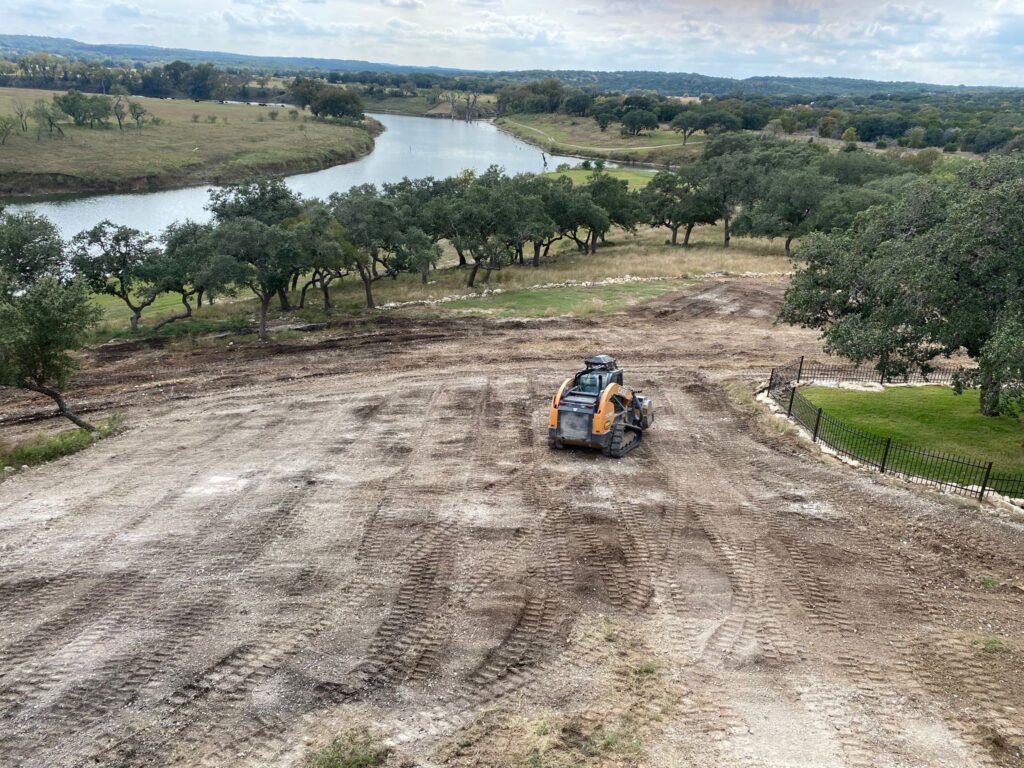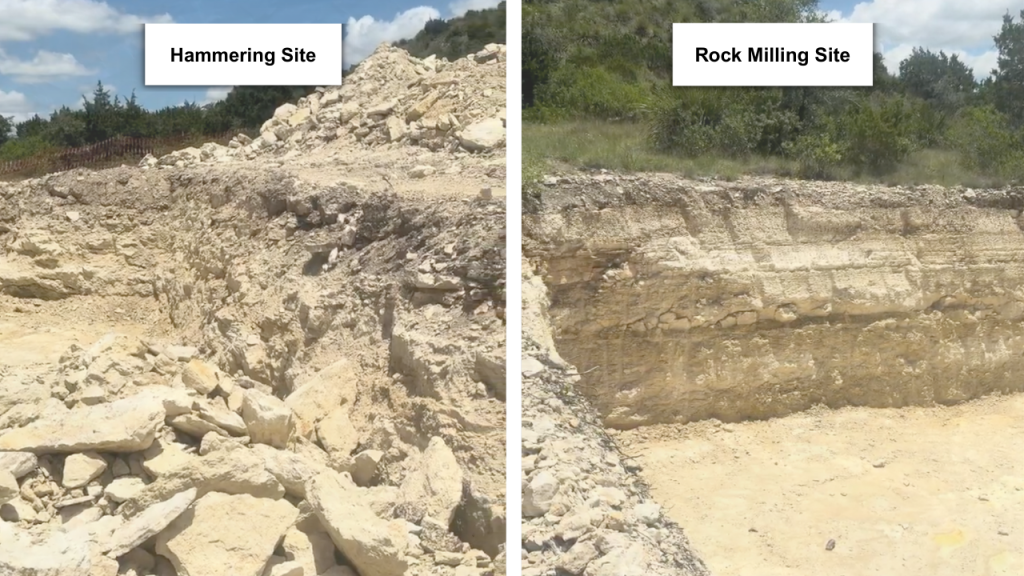We were out at a job site recently when we noticed that the lot next to ours had been excavated using a jackhammer. The lot we were working on and this adjacent job site were relatively similar in terms of size and scope, so we thought this would be the perfect opportunity to compare the results from their hammering vs. our rock milling over on social media:
We’re always talking about why rock milling is the superior method of breaking down the natural barriers on your property—but it was awesome to be able to show our community instead of just telling you! After all, we know that a picture is worth a thousand words…and a video is kind of like getting to see the job site with your own eyes—all without getting any dirt on your boots.
Now that we have these helpful visuals to share, we want to take an even closer look at these two methods of excavation—hammering and rock milling—and dive deeper into some of the key differences with you.
Check out these four factors you’ll want to consider when deciding which method you’ll choose for your next project:
1) FINAL SIZE OF THE RAW MATERIAL

One of the first and most noticeable differences you can see is the size the rock was broken down into. While rock milling breaks down raw material into everything from small pebbles to fine dust, jackhammering breaks barriers down into bigger boulders that are completely unusable and will need to be moved away.
Here are two reasons why the size of your material matters:
#1 – Hauling. Larger barriers get piled up for a future haul-off. They are pretty much useless in their current form unless you need to build a retaining wall.
#2 – Repurposing. When you utilize rock milling, the final result is milled into a product that can be used for foundation material, roads, and even landscaping.
Think of it like coffee beans. Jackhammering leaves you with big beans you can’t brew yet, but rock milling is like grinding them down into a fine product that’s ready to use.
LEARN MORE: Material Production
2) SUSTAINABILITY

We do things the way we do for a reason – it’s efficient, it’s economical, and it’s sustainable. Our state-of-the-art milling process eliminates the need for excessive concrete pouring, reducing concrete exposure and promoting a more sustainable building practice. By milling on-site to repurpose raw material, we can be kind to the land and pass the savings on to you:
- Rocks can be milled on-site to create the base for homes, buildings, or roads.
- Trees and other vegetation can be turned into mulch for landscaping.
- The brush and unwanted trees can be repurposed and return nutrients back into the soil rather than discarding them.
Some contractors work against the earth. Others work with it.
We’re passionate about protecting our planet, and that’s why we embrace sustainable practices!
With us, you can have peace of mind knowing your project will not only improve your property—it’ll also leave the land better than we found it.
LEARN MORE: Unique Challenges to Consider When Building in San Antonio
3) FINAL COST TO YOU
It wouldn’t be a true comparison if we didn’t run the numbers! Let’s take a look at the total estimated cost of a project like the ones shown in the two lots from our video comparison.
If you were using rock milling, the price would be approximately $35,000. This produces a turnkey site complete with efficiently repurposed materials.
You can even visually see the difference in the photos of the two sites. The one done with our advanced milling machines has a clean site with no rock piles.

Now compare that to the site that used jackhammering. On this lot, you can see the hefty piles of large, unusable rock chunks that will need to be dealt with, as well as the jagged rock and soil walls.
For the hammering lot, excavation costs were likely around $25,000 to $30,000, and while that initially seems lower, the cost of hauling off the raw materials is really where you start to see the cost benefits of rock milling. The cost of hauling these materials off likely falls in the range of an additional $50,000 to $60,000, bringing the project total to around $75,000 to $90,000.
$35,000 vs. $90,000—those price differences really add up fast! And that’s not even taking into account the cost of buying and importing new materials to use for base on the hammering lot once the boulders have been hauled away. Be sure to carefully consider the price tag of your entire project rather than just a portion of it to ensure you’re investing in the most cost-effective option.
4) EFFICIENCY
We enjoy being the first ones on a job to start it out on the right foot. That means laying a solid foundation and bringing the expertise to do the job well right off the bat.
Our commitment to top-quality work sets up everyone who comes after us for success. A strong foundation like this is key to avoiding costly delays and mistakes down the line.
You can see from our comparison pictures that the rock milling process left the site in turnkey condition with no additional work or loose ends to be tied up. There was no extra hauling or hidden expenses on the Texas Rock Milling site, and the homeowner was ready to take the next step the moment we finished. With rock milling, we turn a site’s obstacles into assets for their new project—meaning that we repurpose barriers into usable base for the new build right on site.
The site that was jackhammered will still need those piles of rock chunks to be hauled off before they can continue. They’ll also have to pay for, and wait for, brand new materials to be delivered to the site. All of these added steps will end up costing them more than if they had gone with rock milling to begin with.
Think of it this way: if you want a smoothie at home, is it better to toss some fruit in the blender and have a refreshing drink in minutes—or pay extra for a pricey delivery that takes an hour? We say it’s best to use what you’ve already got on hand!
LEARN MORE: Rock Milling
We started Texas Rock Milling because we saw a need to break down barriers across the South Texas Hill Country—but traditional excavation methods just weren’t cutting it. Time and again, we watched people pay far more than necessary to hammer rocks, haul them away, and bring in new material.
That’s why we built a milling business that does things differently.
Instead of hauling raw material off-site, we repurpose it.
It’s not a common approach—it takes a fleet of state-of-the-art milling equipment and years of expertise.
We’ve been working this land for years, and we know the challenges that come with it. No matter the project, we’re mindful of how our work impacts you and your land.
That’s why we’re such firm believers in doing things the Texas Rock Milling way!
We are ready to handle your next project the Texas Rock Milling way and pass the savings on to you. Give us a call or text at 210-854-1362 (or email us at trey@txrockmilling.com) to get started. We can’t wait to start transforming your barriers into assets. Learn more.
